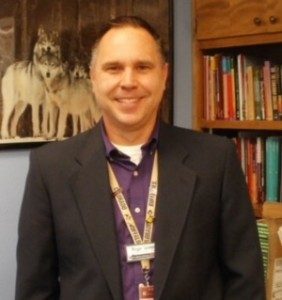A School’s Journey to Promote Student Achievement and Ownership of Learning
CompetencyWorks Blog

Our journey to a true competency-based system has been a long yet rewarding one.
It began with the stark realization that the status quo wasn’t working for our students and far too many of our kids were either not graduating from high school or receiving diplomas and finding themselves ill prepared for the twenty-first century workforce or for college. As you will find, there have been a lot of steps along the way and it has been hard work.
In 2006, a group of principals, teachers, and Adams County School District 50 leaders took a plane north headed for Anchorage, Alaska. Our destination was a small school district near Anchorage called Chugach School District. We had heard about the work of the Chugach District from the Reinventing Schools Coalition (RISC) and we were intrigued by the possibilities. I was especially interested to learn more about how students were being authentically engaged in goal setting and making decisions on what they needed and wanted to learn. I heard that students in Chugach were highly engaged in their learning and were taking responsibility for their own learning at levels that surprised even the Chugach teachers. I traveled a long way see this approach to education in action and I was not disappointed.
Following our week-long visit to schools and workshops with the Chugach School District leaders, teachers, and students, we were convinced this approach made sense and we were determined to figure out how we could reinvigorate learning in our district and in our schools.
I have to give a lot of credit to the teachers and leaders of the Chugach School District. They had a number of great processes and protocols in place for students and teachers designed to promote the success of their standards-based system. The key components to what I experienced were easy to identify, but my mind was filled with many questions about how we would actually be able to implement these key ideas back at my school, Sunset Ridge Elementary. What I saw working in Chugach and what I knew would make a difference for the teaching and learning in my school was threefold:
- Differentiation of instruction must become more meaningful for teachers and students.
- Students must be given more choice within the school day and must take more responsibility for making decisions about what they need to learn.
- Systems need to be in place to promote students to the next higher level when learning mastery of identified have been achieved.

Where to Start?
Fortunately, other District 50 leaders were equally impressed with what they saw happening in the Chugach School District. When our group returned from our Alaska visit, the wheels of implementation began turning on the creation of the District 50 standards-based system (which is now known as a competency-based system). While district administrators, with input from principals and teachers, created a district-wide system that was critical to the reform effort, I focused on building a school culture and climate where the efforts of our reform could take root. The remainder of this article outlines some of the work our staff embarked upon to create a set of specific conditions for learning that have proved successful in promoting high student growth and admirable achievement from our students.
Formative Instructional Practices
Ideas from Tennessee First to the Top and Battelle for Kids, 2011
The focus of our improvement practices was inspired by work done in the state of Tennessee. Tennessee school leaders titled the work, ‘Formative Instructional Practices.’ The core concepts of Formative Instructional Practices (FIP) as defined by me for our staff are:
- Clearly knowing and understanding where we want our students to be performing at the end of a cycle (a cycle could be three weeks, six weeks, a quarter, a semester, or an entire school year). Creating rubrics of proficiency; sharing exemplar work; and routine modeling for students are examples of what all teachers will do/use to communicate end-of-cycle proficiency.
- Adequately and systematically assessing where our students are currently performing. Teachers have a number of assessment tools available to them to assess the current understandings of students. Assessments include: DIBELS; Fountas and Pinnell; Scantron; Progressive Math pre-assessments; and Write from the Beginning pre-assessments.
- Creating action plans designed to take students from where they are currently performing to where we expect them to achieve. Explicitly planning to fill in learning gaps that students lack and set high expectations that challenge students to excel at high levels. Action planning includes identifying resources and instructional strategies that engage students in a variety of relevant learning experiences. Providing feedback; incorporating self/peer-assessments; providing higher order questioning; setting goals; requiring students to track/monitor their own learning; and utilizing flexible grouping are processes that need to be explicitly planned for in each action cycle.
Fidelity of Formative Instructional Practices are evidenced when students can tell me what they are learning, why they are learning it, and how they are learning. Formative Instructional Practices are a process, both formal and informal, that teachers and students use to know where they need to go in the intended learning, where they are in relation to proficiency and how to close the gap to attain proficiency. By using Formative Instructional Practices across our school and across performance levels, we can better ensure that teachers have the data they need to effectively differentiate instruction and students have the information they need to make informed choices for their own education.
Teacher Impact: Data Dialogue Process
To model this process for my teachers, I set up six to eight week data cycles for teachers. I titled the work ‘Teacher Impact: Data Dialogue.’ Throughout the year, Sunset Ridge teachers complete Data Dialogue/Action-Cycle Planners and present their student data to me at the completion of six-eight week instructional cycles. Action-Cycle Planners require teachers to be explicit in identifying the key components of Formative Instructional Practices for each content area (see sample Action-Cycle Planner below). A critical component of the data dialogue process is that teachers are required to share how they engage their students in data dialogue conversations and how their students are tracking and monitoring their own learning using Student Data Notebooks.
Student Data Notebooks
(Ideas for Student Data Notebooks inspired from the Montgomery County Public Schools.) Student Data Notebooks support students in becoming co-producers of their learning. They help students organize processes that promote accelerated and individualized learning. Each Student Data Notebook contains a student’s mission statement, goal setting forms, and individual action plans to support classroom and personal learning.
Student Data Notebooks empower students!
Student Data Notebooks empower students to become accountable for their learning. By writing goals based on subject objectives, students have control over their pace of learning. Goals are written by students to capture short-term wins to help sustain engagement and motivation.
Student Data Notebooks provide feedback!
By analyzing what is working or not working, the notebooks provide opportunities for teachers to give timely feedback to students. Student Action Plans (housed in the Data Notebook) are tools teachers create with students to document the actions teachers, students, and parents will take to support the attainment of goals.
Student Data Notebooks help students manage their learning!
Student Action Plans and Data Notebooks are kept by students! They provide a way for students to set goals, determine learning activities, and manage/track their achievements throughout the school day.
Benefits for Implementing Student Data Notebooks
- Promote student ownership of learning
- Provide multiple opportunities for student goal setting
- Promote student accountability
- Increase student success through authentic motivation
- Promote engagement through relevant experiences
- Help students analyze progress
- Communicate progress to students
- Communicate progress to parents during student-led conferences
- Provide data to teachers to guide in-class support
At Sunset Ridge, Visitors Will SEE:
- Classroom and Student Mission/Vision Statements
- Classroom and Student Goal Statements
- Students working on teacher-led and student-led learning activities aligned with Student Action Plans
- Classroom and individual graphs and charts documenting learning
- Students managing and monitoring achievement data
Visitors to Sunset Ridge Will HEAR:
- Teachers talking to students about data results, goal statements, and plans to accomplish learning
- Students talking about what they are learning
- Students talking to each other about their plans for achieving goals
Visitors to Sunset Ridge Will FEEL:
- A shared responsibility between students and teachers towards achievement of classroom and individual student goals
- Excitement for learning
- A strong commitment to collect and analyze data to improve learning
At Sunset Ridge, our journey is far from complete. We continuously are learning new things about ourselves and about our students, and we make adjustments to our practices to best support the learning of students. This philosophy goes to the heart of CBS.
We are proud of the work we have accomplished and we are proud of our students and parent community for their support of our efforts. It has been refreshing to also receive outside recognition of our school’s successes.
In December 2014, Sunset Ridge was awarded the Governor’s Distinguished Improvement Award. The honor is given to schools that demonstrate excellent student growth as measured by the school performance framework that is used by the state of Colorado to evaluate schools. Award winning schools “exceed” expectations on the indicator related to longitudinal academic growth over the course of three years.
In February 2015, The Foundations for Great Schools awarded our school $30,000 to support a continuation of the effective teaching practices that have resulted in sustained high growth and achievement of Sunset Ridge students. Tom Kaesemeyer, Executive Director of the Fox Family Foundation, said the following: “We commend the award winning schools for their achievements in both academic growth and performance. They are successfully using strategies such as extended days, data‐driven instruction, and technology in the classroom to ensure the success of all their students, despite a range of challenges, from overcrowding to under‐funding.”
Clearly, by implementing the tenets of a competency-based system and learning along the way, our teachers and learners have been invigorated to continue striving for excellence.
Individual Impact: Action-Cycle Planner
| Step 1: Analyze your Data
Briefly summarize strengths and weaknesses found in your data. |
| Reading: Initial Strengths:
Initial Weaknesses: |
| Writing:Initial Strengths:
Initial Weaknesses: |
| Math: Initial Strengths:
Initial Weaknesses: |
| Step 2: SMART Goals for Instructional Cycle
Identify SMART goal statements for the 6-Week Instructional Cycle. |
| Reading: |
| Writing: |
| Math: |
| Step 3: Instructional Plan
Briefly identify specific instructional strategies and approaches to be used during this 6-Week Instructional Cycle. |
| Reading: Teacher Actions:
Student Actions: Parent Partnership: |
| Writing: Teacher Actions:
Student Actions: Parent Partnership: |
| Math: Teacher Actions:
Student Actions: Parent Partnership: |
| Step 4: Impact and Outcomes
What was the result of your work? What achievement did your students attain? What growth did your students make? |
| Reading: Achievement:
Growth from initial assessment: |
| Writing: Achievement:
Growth from initial assessment: |
| Math: Achievement:
Growth from initial assessment: |
Roger Vadeen is the principal of Sunset Ridge Elementary in Adams County School District #50 in Westminster, Colorado.